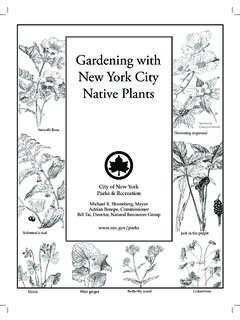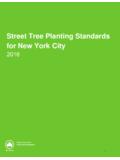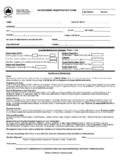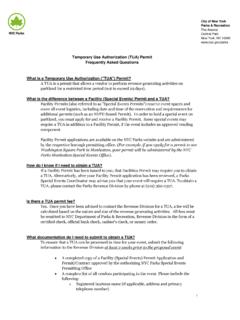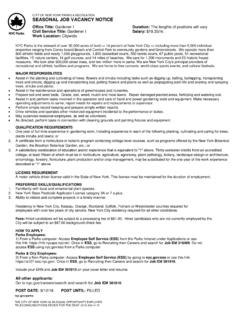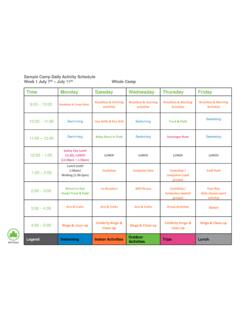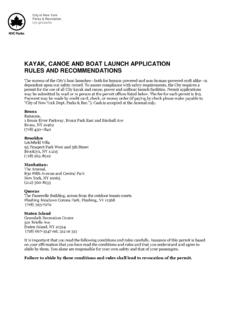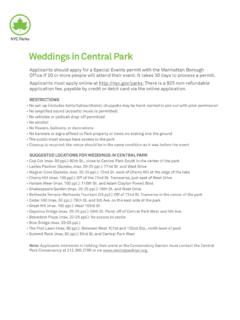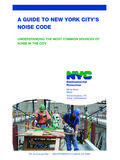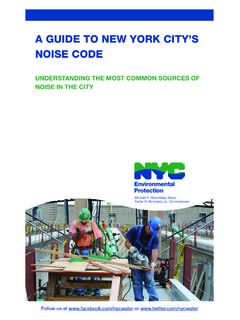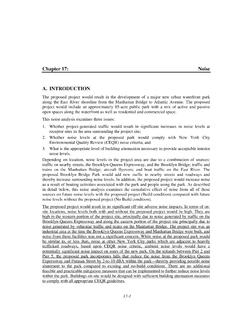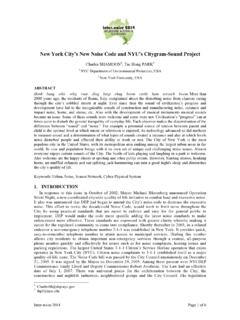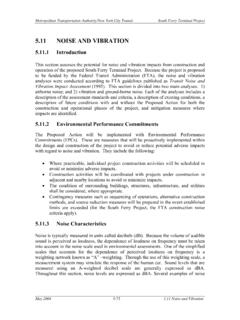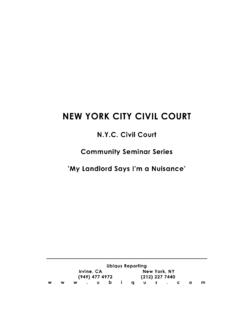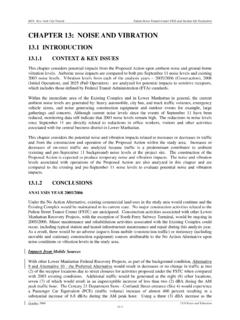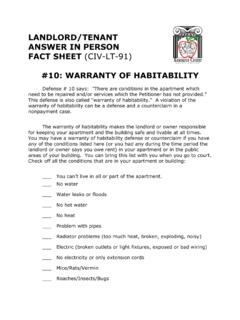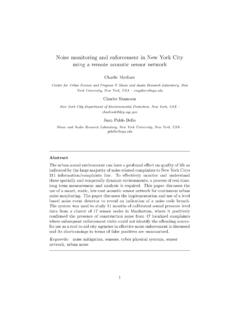Transcription of Chapter 19: Noise A. INTRODUCTION - New York City ...
1 19-1 Chapter 19: Noise A. INTRODUCTION Noise pollution in an urban area comes from many sources. Some sources are activities essential to the health, safety, and welfare of a city s inhabitants, such as Noise from emergency vehicle sirens, garbage collection operations, and construction and maintenance equipment. Other sources, such as traffic, are essential to the viability of a city as a place to live and do business. Although these and other Noise -producing activities are necessary to a city , the Noise they produce is undesirable. Urban Noise detracts from the quality of the living environment, and there is increasing evidence that excessive Noise represents a threat to public health.
2 The Noise analysis presented in this Chapter focuses on Noise sources ( , increased vehicular traffic and stationary Noise sources) that would result from the operation of the proposed project, and the acceptability of ambient Noise levels in the proposed park. Noise effects during construction of the proposed project are analyzed and discussed in Chapter 20, Construction. B. Noise FUNDAMENTALS Quantitative information on the effects of airborne Noise on people is well-documented. If sufficiently loud, Noise may interfere with human activities such as sleep, speech communication, and tasks requiring concentration or coordination. It may also cause annoyance, hearing damage, and other physiological problems. Several Noise scales and rating methods are used to quantify the effects of Noise on people, taking into consideration such factors as loudness, duration, time of occurrence, and changes in Noise level with time.
3 However, it must be noted that all the stated effects of Noise on people vary greatly with each individual. A -WEIGHTED SOUND LEVEL (dBA) Noise is typically measured in units called decibels (dB), which are 10 times the logarithm of the ratio of the sound pressure squared to a standard reference presence squared. Because loudness is important in the assessment of the effects of Noise on people, the dependence of loudness on frequency must be taken into account in the Noise scale used in environmental assessments. One of the simplified scales that accounts for the dependence of perceived loudness on frequency is the use of a weighting network, known as A -weighting, in the measurement system to simulate the response of the human ear. For most Noise assessments, the A-weighted sound pressure level in units of dBA is used in view of its widespread recognition and its close correlation with perception. In the current study, all measured Noise levels are reported in A-weighted decibels (dBA).
4 Common Noise levels in dBA are shown in Table 19-1. ABILITY TO PERCEIVE CHANGES IN Noise LEVELS The average ability of an individual to perceive changes in Noise levels is well-documented (see Table 19-2). Generally, changes in Noise levels of less than 3 dBA are barely perceptible to most listeners, whereas changes in Noise levels of 10 dBA are normally perceived as doubling (or Fresh Kills Park GEIS 19-2 halving) of Noise loudness. These guidelines permit direct estimation of an individual s probable perception of changes in Noise levels. Noise DESCRIPTORS USED IN IMPACT ASSESSMENT Because the sound pressure level unit of dBA describes a Noise level at just one moment, and because very few noises are constant, other ways of describing Noise over more extended periods have been developed.
5 One way is to describe the fluctuating Noise heard over a specific period as if it had been a steady, unchanging sound. For this condition, a descriptor called the equivalent sound level, Leq, can be computed. Leq is the constant sound level that, in a given situation and period ( , 1 hour, denoted by Leq(1), or 24 hours, denoted by Leq(24)), conveys the same sound energy as the actual time-varying sound. Statistical sound level descriptors, such as L1, L10, L50, L90, and Lx, are sometimes used to indicate Noise levels that are exceeded 1, 10, 50, 90, and x percent of the time, respectively. Discrete event peak levels are given as L01 levels. Table 19-1 Common Noise Levels Sound Source (dBA) Military jet, air raid siren 130 Amplified rock music 110 Jet takeoff at 500 meters 100 Freight train at 30 meters 95 Train horn at 30 meters 90 Heavy truck at 15 meters 80 90 Busy city street, loud shout 80 Busy traffic intersection 70 80 Highway traffic at 15 meters, train 70 Predominantly industrial area 60 Light car traffic at 15 meters, city or commercial areas, or residential areas close to industry 50 60 Background Noise in an office 50 Suburban areas with medium-density transportation 40 50 Public library 40 Soft whisper at 5 meters 30 Threshold of hearing 0 Note: A 10 dBA increase in level appears to double the loudness, and a 10 dBA decrease halves the apparent loudness.
6 Sources: Cowan, James P. Handbook of Environmental Acoustics, Van Nostrand Reinhold, New york , 1994. Egan, M. David, Architectural Acoustics. McGraw-Hill Book Company, 1988. Table 19-2 Average Ability to Perceive Changes in Noise Levels Change (dBA) Human Perception of Sound 2 3 Barely perceptible 5 Readily noticeable 10 A doubling or halving of the loudness of sound 20 A dramatic change 40 Difference between a faintly audible sound and a very loud sound Source: Bolt, Beranek and Newman, Inc., Fundamentals and Abatement of Highway Traffic Noise , Report No. PB-222-703. Prepared for Federal Highway Administration, June 1973. Chapter 19: Noise 19-3 For purposes of the proposed project, the maximum 1-hour equivalent sound level (Leq(1)) has been selected as the Noise descriptor to be used in this Noise impact evaluation.
7 Leq(1) is the Noise descriptor recommended for use in the CEQR Technical Manual for vehicular traffic and construction Noise impact evaluation, and is used to provide an indication of highest expected sound levels. The 1-hour L10 is the Noise descriptor used in the CEQR Technical Manual Noise exposure guidelines for city environmental impact review classification. C. Noise STANDARDS AND CRITERIA Noise levels associated with the construction and operation of the proposed project would be subject to the emission source provisions of the New york city Noise Control Code and to Noise criteria set for the CEQR process. Other standards and guidelines promulgated by federal agencies do not apply to project Noise control, but are useful to review in that they establish measures of impacts. Construction equipment is regulated by the Noise Control Act of 1972. NEW york city Noise CONTROL CODE The New york city Noise Control Code, amended in December 2005, contains prohibitions regarding unreasonable Noise , requirements for Noise due to construction activities, and specific Noise standards, including plainly audible criteria for specific Noise sources.
8 In addition, the amended code specifies that no sound source operating in connection with any commercial or business enterprise may exceed the decibel levels in the designated octave bands shown in Table 19-3 at the specified receiving properties. Table 19-3 New york city Noise CodesOctave Band Frequency (Hz) Maximum Sound Pressure Levels (dB) as Measured Within a Receiving Property as Specified Below Residential receiving property for mixed-use building and residential buildings (as measured within any room of the residential portion of the building with windows open, if possible) Commercial receiving property (as measured within any room containing offices within the building with windows open, if possible) 70 74 63 61 64 125 53 56 250 46 50 500 40 45 1000 36 41 2000
9 34 39 4000 33 38 8000 32 37 Source: Section 24-232 of the Administrative Code of the city of New york , as amended December 2005. NEW york CEQR Noise CRITERIA The CEQR Technical Manual contains Noise exposure guidelines for use in city environmental impact review, and required attenuation values to achieve acceptable interior Noise levels. These values are shown in Tables 19-4 and 19-5. Noise exposure is classified into four categories: acceptable, marginally acceptable, marginally unacceptable, and clearly unacceptable. The CEQR Technical Manual criteria are based on maintaining an interior Noise level for the worst-case hour L10 or less than or equal to 45 A-weighted decibels (dBA).
10 Fresh Kills Park GEIS 19-4 NEW york STATE DEPARTMENT OF TRANSPORTATION ENVIRONMETNAL PROCEDURES MANUAL The guidelines of the city Environmental Quality Review (CEQR) Technical Manual will be used to determine appropriate intersection locations for the proposed Noise receptors. In addition to being a destination for new vehicle trips to and from the park, the proposed project would also provide connections to and from the West Shore Expressway, a state highway (Route 440). Although environmental analysis of state roadways under the jurisdiction of the New york State Department of Transportation (NYSDOT) normally follows the procedures contained in the NYSDOT Environmental Procedures Manual (EPM), the CEQR Technical Manual procedures and guidance are generally more stringent and are considered more appropriate for this analysis.

